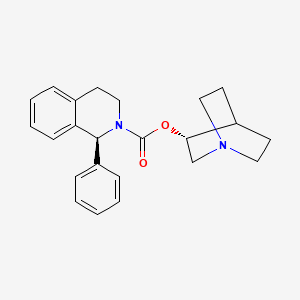

1. 2(1h)-isoquinolinecarboxylic Acid, 3,4-dihydro-1-phenyl-,1- Azabicyclo(2.2.2)oct-3-yl Ester, (r-(r*,s*))-
2. 905, Ym
3. Quinuclidin-3'-yl-1-phenyl-1,2,3,4-tetrahydroisoquinoline-2-carboxylate Monosuccinate
4. Solifenacin Succinate
5. Succinate, Solifenacin
6. Vesicare
7. Ym 905
8. Ym905
1. 242478-37-1
2. Solifenacin (inn)
3. [(3r)-1-azabicyclo[2.2.2]octan-3-yl] (1s)-1-phenyl-3,4-dihydro-1h-isoquinoline-2-carboxylate
4. A8910sqj1u
5. Ym 905
6. Nsc-759144
7. Solifenacin [inn]
8. Soliten
9. Solifenacin [inn:ban]
10. Chembl1200803
11. (+)-solifenacin
12. (3r)-1-azabicyclo[2.2.2]octan-3-yl (1s)-1-phenyl-1,2,3,4-tetrahydroisoquinoline-2-carboxylate
13. Ncgc00168778-01
14. Unii-a8910sqj1u
15. ((8r)-1-azabicyclo(2.2.2)octan-8-yl) (1s)-1-phenyl-3,4-dihydro-1h-isoquinoline-2-carboxylate
16. [(8r)-1-azabicyclo[2.2.2]octan-8-yl] (1s)-1-phenyl-3,4-dihydro-1h-isoquinoline-2-carboxylate
17. Solifenacin-succinate
18. Solifenacin [mi]
19. Solifenacin [vandf]
20. Chembl1734
21. Solifenacin [who-dd]
22. Schembl188493
23. Gtpl7483
24. Schembl9971260
25. Dtxsid3048289
26. Chebi:135530
27. Hms3886o15
28. Hy-a0034
29. Zinc3936683
30. Bdbm50344284
31. Bdbm50370682
32. S5238
33. Akos015896445
34. Ccg-268199
35. Cs-8096
36. Db01591
37. Nsc 759144
38. Ncgc00168778-06
39. Db-001095
40. A16947
41. D08522
42. Ab01565949_02
43. (s)-(r)-quinuclidin-3-yl 1-phenyl-3,4-dihydroisoquinoline-2(1h)-carboxylate
44. ((8r)-1-azabicyclo(2.2.2)octan-8-yl)(1s)-1-phenyl-3,4-dihydro-1h-isoquinoline-2-carboxylate
45. (1s)-(3r)-1-azabicyclo[2.2.2]oct-3-yl-3,4-dihydro-1-phenyl-2(1h)-isoquinolinecarboxylate
46. 1172613-99-8
47. 2(1h)-isoquinolinecarboxylic Acid, 3,4-dihydro-1-phenyl-,(3r)-1-azabicyclo[2.2.2]oct-3-yl Ester, (1s)-
48. 2(1h)-isoquinolinecarboxylic Acid, 3,4-dihydro-1-phenyl-,1-azabicyclo(2.2.2)oct-3-yl Ester, (r-(r*,s*))-
| Molecular Weight | 362.5 g/mol |
|---|---|
| Molecular Formula | C23H26N2O2 |
| XLogP3 | 4 |
| Hydrogen Bond Donor Count | 0 |
| Hydrogen Bond Acceptor Count | 3 |
| Rotatable Bond Count | 3 |
| Exact Mass | 362.199428076 g/mol |
| Monoisotopic Mass | 362.199428076 g/mol |
| Topological Polar Surface Area | 32.8 Ų |
| Heavy Atom Count | 27 |
| Formal Charge | 0 |
| Complexity | 525 |
| Isotope Atom Count | 0 |
| Defined Atom Stereocenter Count | 2 |
| Undefined Atom Stereocenter Count | 0 |
| Defined Bond Stereocenter Count | 0 |
| Undefined Bond Stereocenter Count | 0 |
| Covalently Bonded Unit Count | 1 |
Solifenacin tablets are indicated to treat an overactive bladder with urinary incontinence, urgency, and frequency.
FDA Label
Solifenacin antagonizes the M2 and M3 muscarinic receptors in the bladder to treat an overactive bladder. It has a long duration of action as it is usually taken once daily. Patients taking solifenacin should be aware of the risks of angioedema and anaphylaxis.
Muscarinic Antagonists
Drugs that bind to but do not activate MUSCARINIC RECEPTORS, thereby blocking the actions of endogenous ACETYLCHOLINE or exogenous agonists. Muscarinic antagonists have widespread effects including actions on the iris and ciliary muscle of the eye, the heart and blood vessels, secretions of the respiratory tract, GI system, and salivary glands, GI motility, urinary bladder tone, and the central nervous system. (See all compounds classified as Muscarinic Antagonists.)
Urological Agents
Drugs used in the treatment of urological conditions and diseases such as URINARY INCONTINENCE and URINARY TRACT INFECTIONS. (See all compounds classified as Urological Agents.)
G04BD08
S76 | LUXPHARMA | Pharmaceuticals Marketed in Luxembourg | Pharmaceuticals marketed in Luxembourg, as published by d'Gesondheetskeess (CNS, la caisse nationale de sante, www.cns.lu), mapped by name to structures using CompTox by R. Singh et al. (in prep.). List downloaded from https://cns.public.lu/en/legislations/textes-coordonnes/liste-med-comm.html. Dataset DOI:10.5281/zenodo.4587355
G - Genito urinary system and sex hormones
G04 - Urologicals
G04B - Urologicals
G04BD - Drugs for urinary frequency and incontinence
G04BD08 - Solifenacin
Absorption
Solifenacin is well absorbed in the duodenum, jejunum, and ileum but not the stomach. Absorption occurs via passive diffusion and so no transporters are involved. The mean oral bioavailability of solifenacin is 88%. The Tmax of solifenacin is 3-8 hours with a Css of 32.3ng/mL for a 5mg oral dose and 62.9ng/mL for a 10mg oral dose.
Route of Elimination
69.27.8% of a radiolabelled dose is recovered in the urine, 22.53.3% was recovered in feces, and 0.47.8% was recovered in exhaled air. 18% of solifenacin is eliminated as the N-oxide metabolite, 9% is eliminated as the 4R-hydroxy N-oxide metabolite, and 8% is eliminated as the 4R-hydroxy metabolite.
Volume of Distribution
The volume of distribution of solifenacin is 600L.
Clearance
The clearance of solifenacin is 7-14L/h and a renal clearance of 0.67-1.51L/h.
Solifenacin undergoes N-oxidation at the quinuclidin ring by cytochrome P450, though the exact enzymes are not revealed in the literature. The tetrahydroisoquinolone ring is 4R-hydroxylated by CYP3A4, CYP1A1, and CYP2D6. A 4R-hydroxy N-oxide metabolite is also formed by CYP3A4. Finally, solifenacin can undergo direct glucuronidation. Only solifenacin and the 4R-hydroxy metabolite are pharmacologically active.
The elimination half life of solifenacin ranges from 33-85 hours.
Solifenacin is a competitive muscarinic receptor antagonist. It has the highest affinity for M3, M1, and M2 muscarinic receptors. 80% of the muscarinic receptors in the bladder are M2, while 20% are M3. Solifenacin's antagonism of the M3 receptor prevents contraction of the detrusor muscle, while antagonism of the M2 receptor may prevent contraction of smooth muscle in the bladder.
MARKET PLACE

